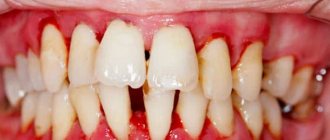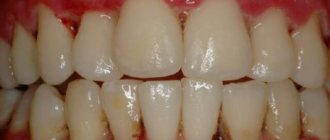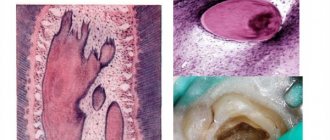Gingivitis is inflammation of the gums. The gums are inflamed in the vast majority of the world's population. Therefore, it is a common joke among dentists that it is possible to diagnose any patient, even if he did not have time to enter the office. This diagnosis, as you may have guessed, is “gingivitis.” This article will discuss the classification, pathogenesis and causes of gingivitis.
Gingivitis is the earliest stage of gum inflammation. Over time, the inflammation becomes more severe, the connection between the gum and tooth is destroyed (epithelial attachment - number 3 in the figure), and “gingivitis” changes to “periodontitis”.
To easily identify pathology, you need to remember the norm. Let's remember what a normal, non-inflamed gum looks like.
What is gingivitis
Gingivitis is treated by a periodontist.
Gingivitis is an inflammatory process that occurs inside the gums, sometimes accompanied by symptoms such as pain, swelling, swelling of the affected area and a general rise in body temperature. Gingivitis can occur in patients under a variety of circumstances; Inflammation such as gingivitis can occur due to traumatic effects on the gums, penetration of pathogenic microbes into the gums, hypothermia of the body, a sharp drop in immunity, deficiency of certain vitamins, and for other reasons.
Classification
Hypertrophic gingivitis is classified both by clinical and structural changes and by the intensity of the inflammatory process. Depending on the structural changes in the gum tissue, edematous and fibrous forms are distinguished:
- In the edematous form, the patient complains of soreness and bleeding of the gums, which become bright red, and the interdental papillae greatly increase in volume and overlap the crowns of the teeth.
- In the fibrous form, pain and bleeding are not observed, the color of the gums remains pale pink, the patient complains mainly about changes in the appearance of the gums.
Depending on the severity of the inflammatory process, three degrees of development of the disease are distinguished:
- 1st degree - the edge of the gum grows intensively, the gingival papillae at their base increase;
- 2nd degree - hypertrophy of the gum edge and gingival papillae progresses, the papillae acquire a dome-shaped shape, the overgrown edge covers the crowns of the teeth almost to half;
- 3rd degree - hyperplasia of the gum edge and gingival papillae is pronounced, the overgrown gum covers almost the entire tooth crown, right up to the surface of the teeth, the gingival papillae are covered with painful bleeding granulations.
Symptoms of gingivitis
How does gingivitis manifest? Externally, it can be difficult to suspect the onset of this disease, since in the initial stages gingivitis can go unnoticed. In the initial stages, gingivitis is much easier to detect by a dentist; it most often occurs during routine examinations or when a patient visits a dental clinic with another problem. Due to the fact that many people are in no hurry to see a dentist on time and self-medicate, the disease starts and the pathology progresses.
Bleeding of the gum mucosa is the main, most common and most important sign of gingivitis. But at the initial stage of gingivitis, the gums bleed inconsistently; bleeding occurs after any impact on the gums, for example, when biting and chewing too hard food or while brushing your teeth.
Itching with gingivitis: severe pain in the gum area during the initial stage of the disease occurs quite rarely, but the feeling that they itch is quite common. As inflammation progresses, gum sensitivity increases.
Swelling with gingivitis: not only the mucous membrane itself swells, but also the interdental spaces, they increase in volume, their color changes (redness, cyanosis).
Plaque in gingivitis: soft plaque and tartar are found on both the outside and inside of the teeth. Plaque can penetrate under the gums. A white coating may also appear on the tongue.
If the symptoms of gingivitis were not noticed in time and treatment was not started on time, then the bleeding of the gums intensifies and the patient detects traces of blood on food when biting into it. Moreover, if at first when biting, blood remains only on hard foods, for example, on apples, then later, with the further development of the inflammatory process, blood begins to remain even on relatively soft food.
Disease prevention
To prevent your gums from suddenly becoming inflamed, you should adhere to simple measures to prevent gingivitis:
- regularly brush your teeth and tongue using a soft brush;
- use dental floss to clean interdental spaces;
- Visit the dentist at least once every six months.
If you or your loved ones notice unpleasant symptoms, we advise you to immediately seek advice from the SM-Dentistry clinic. To make an appointment, call or fill out the form on the website.
Professional teeth cleaning
It is important to start treating gingivitis as early as possible
Timely initiation of treatment for gingivitis allows you to completely restore the health of the affected areas of the gums, stop the further development of the inflammatory process and prevent the development of dangerous complications .
Seeking help from a dentist immediately after discovering gingivitis will prevent such a common complication as periodontitis, where not only the mucous membrane of the gums is exposed to the inflammatory process, but also the periodontal tissues that hold the teeth in the sockets: as a result of the onset of periodontitis, the teeth begin to become loose, then become pathologically mobile and subsequently, if treatment is not started in time, they will fall out.
Prices
| Name of service | Price, rub.) * |
| Comprehensive oral hygiene (OptraGate oral cavity isolation, AirFlow removal of colored plaque, ultrasonic removal of dental plaque, polishing with paste, preventive fluoridation of teeth) | 7,000 rub. |
| Initial consultation with a dentist-therapist | 1,500 rub. |
| Repeated consultation with a dentist-therapist | 800 rub. |
We accept VISA, MASTERCARD, MAESTRO bank cards for payment.
Would you like us to call you back?
Causes of gingivitis
In addition to gum injury and other factors, a common cause of gingivitis is the accumulation of microbial plaque and the presence of tartar in the form of supragingival and subgingival deposits. Such situations arise due to insufficient and improper oral hygiene.
Symptoms of gingivitis can develop against the background of a general weakening of the immune system, with diseases of the cardiovascular system, gastritis, ulcers, diabetes, vitamin deficiency (often with a lack of vitamins B, C, E), various infectious diseases, and prolonged exposure to medications, such as antibiotics. Sometimes the trigger for the development of gingivitis is stress-related periods of life, such as: dismissal from work, pregnancy, menopause, adolescence. Gingivitis often develops during exacerbations of chronic diseases in older people.
Forms of gingivitis
Before answering the question about treating gingivitis, you need to know that gingivitis comes in different forms.
Catarrhal gingivitis is the most common form of the disease; It is catarrhal gingivitis that is diagnosed in most patients. With this form of gingivitis, bleeding gums are detected and pain appears when pressing on the inflamed areas of the gums. Catarrhal gingivitis can be chronic, when the symptoms and course of the disease are long-term and sluggish, and acute manifestations of catarrhal gingivitis can also occur.
If you visit a dental clinic in a timely manner, treatment of gingivitis can take 1-2 weeks and be cured completely, without traces. Other forms of gingivitis are less responsive to treatment and require longer periods of therapy.
Hypertrophic gingivitis – this form of gingivitis most often occurs at a young age. Most often, inflammation in hypertrophic gingivitis is localized in the area of the front teeth. The peculiarity of this type of gingivitis is the proliferation of interdental papillae, hyperplasia of the gingival tissue, and proliferation of the mucous membrane. With hypertrophic gingivitis, fibrous and edematous forms are distinguished.
Necrotizing ulcerative gingivitis: diagnosed with advanced inflammation. The ulcerative-necrotic form of gingivitis is accompanied by severe pain, the presence of ulcers on the gums, increased salivation, inflammation of the lymph nodes, fever, headache, lack of appetite and necrosis of soft tissues.
Atrophic gingivitis is the most severe form of gingivitis, the course of which occurs with atrophy of the gum tissue and periodontal death, while the necks of the teeth are exposed. The mucous membrane of the area where the inflammation spreads may acquire a grayish tint, and an unpleasant putrid odor appears from the mouth.
Against the background of atrophic gingivitis, the patient experiences general weakness and weakness; even an attempt to routinely brush the teeth brings the patient significant discomfort, bleeding, separation of purulent contents and pain. Atrophic gingivitis can occur as a result of incorrectly performed orthodontic treatment (implantation, prosthetics), wearing incorrectly made, uncorrected uncomfortable dental structures that put painful pressure on the gums and disrupt local blood circulation.
About tooth loss and how to avoid it
Last year, we, at Star Smile, released a cartoon video in which the heroine was thinking about what to do - either start bite treatment when she was young, or wait until all the teeth begin to decay. Here he is, by the way
The video received quite a lot of views and responses, many patients asked us to continue the topic of consequences - to show readers what inattention and carelessness when caring for teeth and gums can lead to. Therefore, we will continue to educate you and hope that our articles will help you contact doctors in a timely manner and avoid most of the problems that we write about.
Diagnosis of gingivitis, differences from other oral pathologies
At the diagnostic stage, it is extremely important to separate gingivitis from diseases of the teeth and oral cavity, such as periodontitis and periodontal disease, since periodontitis therapy follows a different scheme.
With various forms of gingivitis, it is usually the gums that become inflamed. At the same time, periodontitis and periodontal disease expose bone tissue and periodontal tissue, which are responsible for fixing and holding teeth in the sockets, to inflammatory and destructive processes.
In advanced, untreated forms of periodontitis and periodontal disease, loosening and displacement of teeth occur with further loss, the affected teeth fall out, and tissue damage remains in their place.
With the chronic development of periodontal disease due to advanced gingivitis, the process of gum inflammation may no longer be observed. In advanced stages of periodontitis and periodontal disease, dentists often have to resort to removing a tooth or several teeth, since these teeth are a source of dangerous infection spreading throughout the body and contribute to the worsening of the underlying disease.
In severely advanced cases of inflammation, dentists are no longer faced with the task of restoring the affected teeth and mucous membranes; The main goal in the case of advanced forms of inflammation is to restore the normal state of the patient’s oral cavity as a whole and, subsequently, after the end of treatment of advanced gingivitis and their complications, to plan prosthetics for lost teeth.
Only if treatment for gingivitis is started in a timely manner, provided that serious complications have been avoided, can the patient and doctors count on keeping their teeth intact and in perfect order. After treatment and complete recovery, the patient must periodically visit the dental clinic for preventive examinations in the dentist's chair. Preventive examinations can reduce the time for dental treatment (if any pathologies are detected in a timely manner) and significantly reduce the cost of dental care.
Our doctors
18 years of experience
Baghdasaryan
Armen Evgenievich
Chief physician, dentist-orthopedist-therapist
Graduated from VSMA named after. N.N. Burdenko. Internship on the basis of MGMSU named after. A.E. Evdokimov in “General Dentistry”.
Clinical residency at the Moscow State Medical University named after. A.E. Evdokimov in “Orthopedics”.
More about the doctor...
5 years experience
Sadina
Ekaterina Vladislavovna
Dental therapist, surgeon
Penza State University Medical Institute, specialty “Dentistry”.
In 2021, she underwent professional retraining in the specialty “Therapeutic Dentistry” at the Moscow State Medical and Dental University named after A.I. Evdokimov.
More about the doctor...
8 years of experience
Arzumanov
Andranik Arkadievich
Dentist-orthodontist
Graduated from Moscow State Medical University. Internship - Moscow State Medical University at the Department of Orthodontics and Children's Prosthetics.
Residency at Moscow State Medical University at the Department of Orthodontics and Children's Prosthetics. Member of the Professional Society of Orthodontists of Russia since 2010.
More about the doctor...
Procedure for diagnosing gingivitis
The dentist in a clinic first of all diagnoses gingivitis and determines its form. During the examination, the degree of gum damage is determined, the etiology of the disease is determined (determining the gate of infection to the site of inflammation). To do this, dentists may prescribe radiography, OPTG, computed tomography and other diagnostic tests to assess the extent of the lesions and determine the form of gingivitis.
Only after the indicated studies and the availability of a complete picture of the disease can dentists begin to treat gingivitis using certain selected treatment tactics.
Treatment and prevention of gingivitis
Treatment of gingivitis, firstly, depends on the form of the disease and has certain differences. As a rule, the patient is asked to undergo the same set of medical procedures, taking into account the individual characteristics of the body, the presence of complications and the course of the disease.
Medical procedures in the treatment of various forms of gingivitis and the presence of complications are aimed at eliminating the inflammatory process in the gums and eliminating the causes of the inflammatory process.
Carrying out professional oral hygiene for gingivitis is a primary prerequisite for quick and successful treatment, as well as rehabilitation in the future. The dentist carefully removes plaque, gum plaque and hard tartar; subgingival and dental deposits are also removed using an Air Flow device or ultrasound.
Mandatory sanitation (treatment of caries) of the oral cavity in case of gingivitis: all carious cavities in the patient’s teeth must be eliminated; teeth and roots are removed; if the patient has orthopedic devices, for example, dentures, if necessary, they should be adjusted to the current state of the oral cavity, while the risk of the spread of pathogenic bacteria is minimized, especially during the period of rehabilitation of gingivitis.
Prescribed medications for the treatment of gingivitis: when treating gingivitis of various forms, dentists may prescribe anti-inflammatory drugs, antibiotics, antiseptics in the form of mouth rinses and applications, agents for accelerating epithelization of the gum mucosa and agents for rapid healing of ulcers and suppression of inflammation (oils, vitamin E, “Solcoseryl-gel”), vitamin complexes, antioxidants, medicines to improve metabolism.
Surgical methods for treating gingivitis
In the hypertrophic form of gingivitis, to treat it, a dental surgeon can perform excision of overgrown tissue, gingivectomy, and gum surgery. For atrophic gingivitis - gingivoplasty (replacement of atrophied gum tissue).
Professional oral hygiene for gingivitis
After professional oral hygiene procedures, the patient must temporarily change his toothbrush; during rehabilitation, he must purchase a new toothbrush with soft bristles, then a medium-hard brush can be used, which begins to be used after completing the course of therapy.
Strengthening daily hygiene to prevent recurrence of gingivitis: it is recommended for a patient who has undergone treatment for gingivitis to purchase a mouthwash, irrigator and floss. Your dentist will advise you on how to properly clean your teeth and gums.
Reasons for the development of the disease
The main factor in the development of inflammation is insufficient oral hygiene, due to which microbial plaque thickens and forms into tartar.
Teenagers and pregnant women are most susceptible to the disease due to hormonal changes in the body. Also at risk are people with diagnoses such as:
- diabetes;
- avitaminosis;
- HIV;
- leukemia;
- diseases of the digestive tract.
Even minor trauma to the oral mucosa becomes a favorable environment for the development of infection. That is why congenital malocclusion, unpolished fillings, sharp edges of dentures, as well as using a hard toothbrush and eating hard foods can lead to gingivitis.










